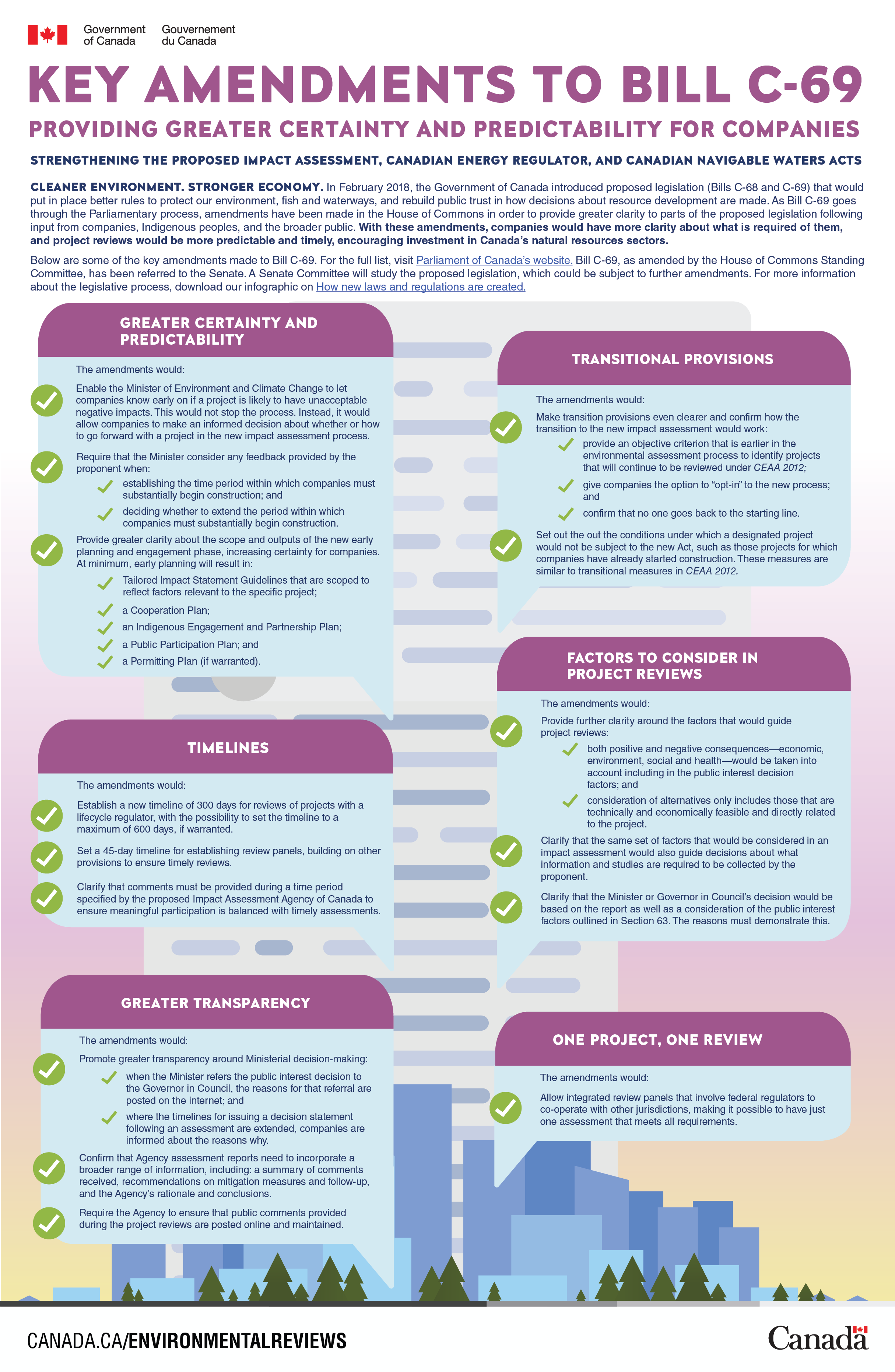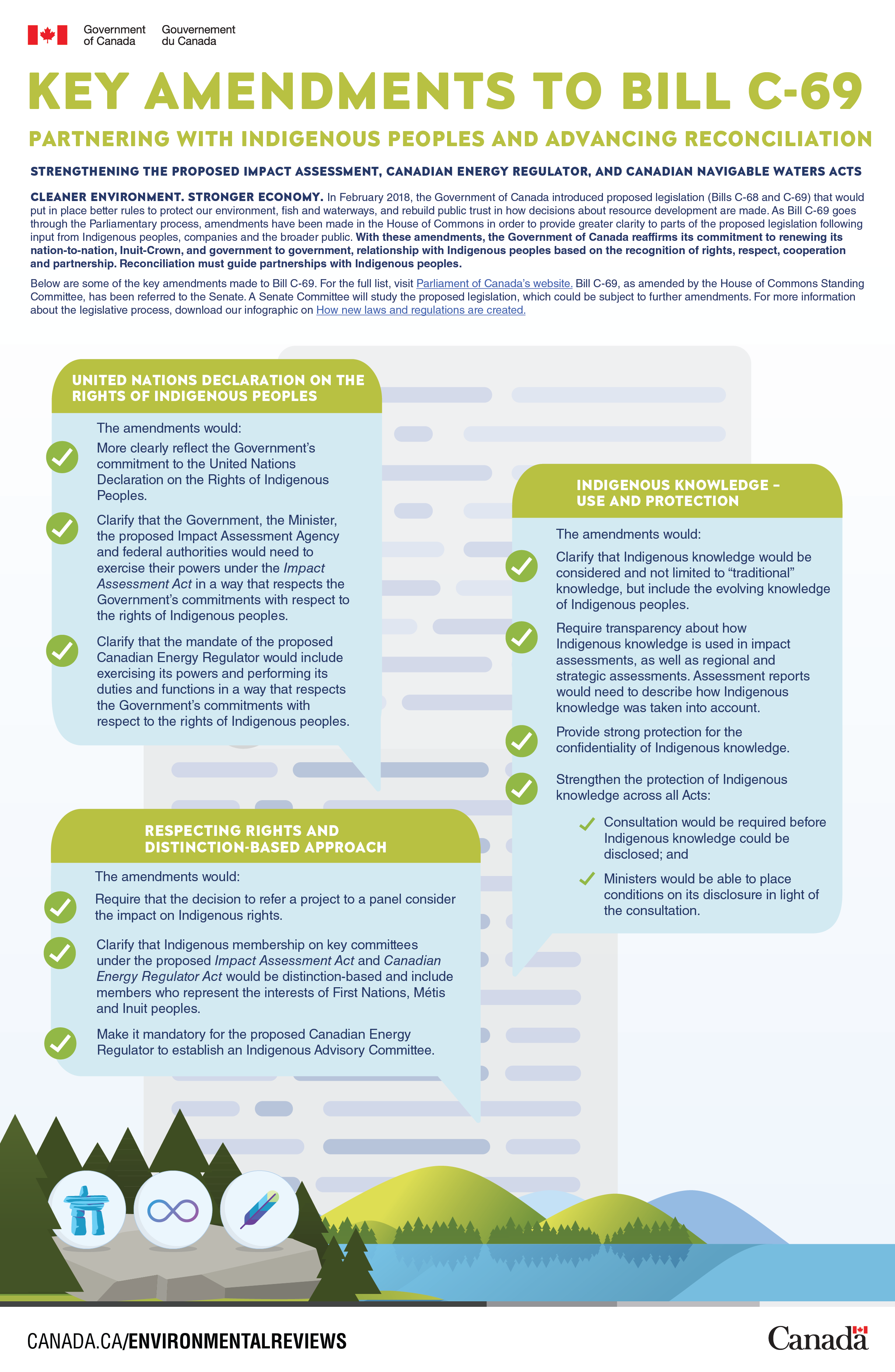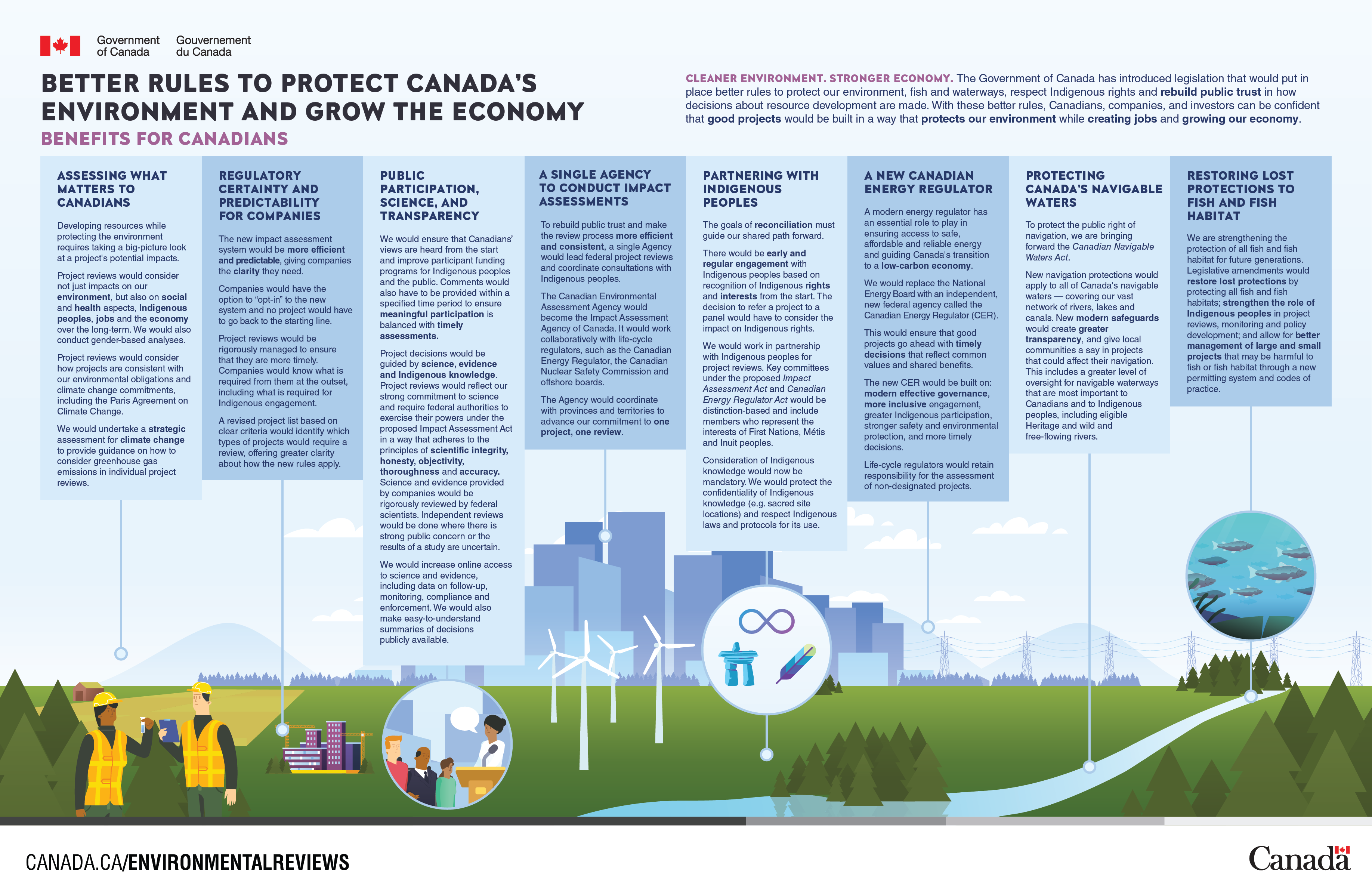Bill Amendments
In June 2018, both Bill-68 and Bill C-69 passed in the House of Commons with amendments following feedback from Indigenous peoples, companies, and Canadians. Visit the Parliament of Canada website for the full list of Bill C-68 amendments and Bill C-69 amendments. Both Bills will go to the Senate for review in the fall.
Learn more about what some of the key changes may mean to you:
Companies
Infographic: Key amendments to Bill C-69 for companies
Click on image to enlarge
Long description
Key amendments to bill c-69 providing greater certainty and predictability for companies
Strengthening the Proposed Impact Assessment, Canadian Energy Regulator, and Canadian Navigable Waters Acts
CLEANER ENVIRONMENT. STRONGER ECONOMY. In February 2018, the Government of Canada introduced proposed legislation (Bills C-68 and C-69) that would
put in place better rules to protect our environment, fish and waterways, and rebuild public trust in how decisions about resource development are made. As Bill C-69 goes
through the Parliamentary process, amendments have been made in the House of Commons in order to provide greater clarity to parts of the proposed legislation following
input from companies, Indigenous peoples, and the broader public. With these amendments, companies would have more clarity about what is required of them,
and project reviews would be more predictable and timely, encouraging investment in Canada’s natural resources sectors.
Below are some of the key amendments made to Bill C-69. For the full list, visit Parliament of Canada’s website. Bill C-69, as amended by the House of Commons Standing
Committee, has been referred to the Senate. A Senate Committee will study the proposed legislation, which could be subject to further amendments. For more information
about the legislative process, download our infographic on How new laws and regulations are created.
Greater Certainty and Predictability
The amendments would:
- Enable the Minister of Environment and Climate Change to let companies know early on if a project is likely to have unacceptable negative impacts. This would not stop the process. Instead, it would allow companies to make an informed decision about whether or how to go forward with a project in the new impact assessment process.
- Require that the Minister consider any feedback provided by the proponent when:
- establishing the time period within which companies must substantially begin construction; and
- deciding whether to extend the period within which companies must substantially begin construction.
- Provide greater clarity about the scope and outputs of the new early planning and engagement phase, increasing certainty for companies. At minimum, early planning will result in:
- Tailored Impact Statement Guidelines that are scoped to reflect factors relevant to the specific project;
- a Cooperation Plan;
- an Indigenous Engagement and Partnership Plan;
- a Public Participation Plan; and
- a Permitting Plan (if warranted).
Transitional Provisions
The amendments would:
- Make transition provisions even clearer and confirm how the transition to the new impact assessment would work:
- provide an objective criterion that is earlier in the environmental assessment process to identify projects that will continue to be reviewed under CEAA 2012;
- give companies the option to “opt-in” to the new process; and
- confirm that no one goes back to the starting line.
- Set out the out the conditions under which a designated project would not be subject to the new Act, such as those projects for which companies have already started construction. These measures are similar to transitional measures in CEAA 2012.
Timelines
The amendments would:
- Establish a new timeline of 300 days for reviews of projects with a lifecycle regulator, with the possibility to set the timeline to a maximum of 600 days, if warranted.
- Set a 45-day timeline for establishing review panels, building on other provisions to ensure timely reviews.
- Clarify that comments must be provided during a time period specified by the proposed Impact Assessment Agency of Canada to ensure meaningful participation is balanced with timely assessments.
Factors to Consider in Project Reviews
The amendments would:
- Provide further clarity around the factors that would guide project reviews:
- both positive and negative consequences—economic, environment, social and health—would be taken into account including in the public interest decision factors; and
- consideration of alternatives only includes those that are technically and economically feasible and directly related to the project.
- Clarify that the same set of factors that would be considered in an impact assessment would also guide decisions about what information and studies are required to be collected by the proponent.
- Clarify that the Minister or Governor in Council’s decision would be based on the report as well as a consideration of the public interest factors outlined in Section 63. The reasons must demonstrate this.
Greater Transparency
The amendments would:
- Promote greater transparency around Ministerial decision-making:
- when the Minister refers the public interest decision to the Governor in Council, the reasons for that referral are posted on the internet; and
- where the timelines for issuing a decision statement following an assessment are extended, companies are informed about the reasons why.
- Confirm that Agency assessment reports need to incorporate a broader range of information, including: a summary of comments received, recommendations on mitigation measures and follow-up, and the Agency’s rationale and conclusions.
- Require the Agency to ensure that public comments provided during the project reviews are posted online and maintained.
One Project, One Review
The amendments would:
Allow integrated review panels that involve federal regulators to co-operate with other jurisdictions, making it possible to have just one assessment that meets all requirements.
Indigenous communities
Infographic: Key amendments to Bill C-69 for Indigenous communities
Click on image to enlarge
Long description
Key Amendments to Bill C-69
Partnering with Indigenous Peoples and Advancing Reconciliation
Strengthening the Proposed Impact Assessment, Canadian Energy Regulator, and Canadian Navigable Waters Acts
CLEANER ENVIRONMENT. STRONGER ECONOMY. In February 2018, the Government of Canada introduced proposed legislation (Bills C-68 and C-69) that would put in place better rules to protect our environment, fish and waterways, and rebuild public trust in how decisions about resource development are made. As Bill C-69 goes through the Parliamentary process, amendments have been made in the House of Commons in order to provide greater clarity to parts of the proposed legislation following input from Indigenous peoples, companies and the broader public. With these amendments, the Government of Canada reaffirms its commitment to renewing its nation-to-nation, Inuit-Crown, and government to government, relationship with Indigenous peoples based on the recognition of rights, respect, cooperation and partnership. Reconciliation must guide partnerships with Indigenous peoples.
Below are some of the key amendments made to Bill C-69. For the full list, visit Parliament of Canada’s website. Bill C-69, as amended by the House of Commons Standing Committee, has been referred to the Senate. A Senate Committee will study the proposed legislation, which could be subject to further amendments. For more information about the legislative process, download our infographic on How new laws and regulations are created.
United Nations Declaration on the Rights of Indigenous Peoples
The amendments would:
- More clearly reflect the Government’s commitment to the United Nations Declaration on the Rights of Indigenous Peoples.
- Clarify that the Government, the Minister, the proposed Impact Assessment Agency and federal authorities would need to exercise their powers under the Impact Assessment Act in a way that respects the Government’s commitments with respect to
the rights of Indigenous peoples. - Clarify that the mandate of the proposed Canadian Energy Regulator would include exercising its powers and performing its duties and functions in a way that respects the Government’s commitments with respect to the rights of Indigenous peoples.
Indigenous Knowledge - Use and Protection
The amendments would:
- Clarify that Indigenous knowledge would be considered and not limited to “traditional” knowledge, but include the evolving knowledge of Indigenous peoples.
- Require transparency about how Indigenous knowledge is used in impact assessments, as well as regional and strategic assessments. Assessment reports would need to describe how Indigenous knowledge was taken into account.
- Provide strong protection for the confidentiality of Indigenous knowledge.
- Strengthen the protection of Indigenous knowledge across all Acts:
- Consultation would be required before Indigenous knowledge could be disclosed; and
- Ministers would be able to place conditions on its disclosure in light of the consultation.
Respecting Rights and Distinctions-Based Approach
The amendments would:
- Require that the decision to refer a project to a panel consider the impact on Indigenous rights.
- Clarify that Indigenous members on key committees under the proposed Impact Assessment Act and Canadian Energy Regulator Act would be distinction-based and include members who represent the interests of First Nations, Métis and Inuit peoples.
- Make it mandatory for the proposed Canadian Energy Regulator to establish an Indigenous Advisory Committee.
Canadians
Infographic: Benefits for Canadians
Click on image to enlarge
Long description
Cleaner environment. Stronger economy. The Government of Canada has introduced legislation that would put in place better rules to protect our environment, fish and waterways, respect Indigenous rights and rebuild public trust in how decisions about resource development are made. With these better rules, Canadians, companies, and investors can be confident that good projects will be built in a way that protects our environment while creating jobs and growing our economy.
Assessing what matters to Canadians
Developing resources while protecting the environment requires taking a big-picture look at a project's potential impacts.
Project reviews would consider not just impacts on our environment, but also on social and health aspects, Indigenous peoples, jobs and the economy over the long-term. We will also conduct gender-based analyses.
Project reviews would consider how projects are consistent with our environmental obligations and climate change commitments, including the Paris Agreement on Climate Change.
We would undertake a strategic assessment for climate change to provide guidance on how to consider greenhouse gas emissions in individual project reviews.
Regulatory certainty and predictability for companies
The new impact assessment system would be more efficient and predictable, giving companies the clarity they need.
Companies would have the option to “opt-in” to the new system and no project would have to go back to the starting line.
Project reviews would be rigorously managed to ensure that they are more timely. Companies will know what is required from them at the outset, including what is required for Indigenous engagement.
A revised project list based on clear criteria would identify which types of projects would require a review, offering greater clarity about how the new rules apply.
Public participation, science, and transparency
We would ensure that Canadians’ views are heard from the start and improve participant funding programs for Indigenous peoples and the public. Comments would also have to be provided within a specified time period to ensure meaningful participation is balanced with timely assessments.
Project decisions would be guided by science, evidence and Indigenous knowledge. Project reviews would reflect our strong commitment to science and require federal authorities to exercise their powers under the proposed Impact Assessment Act in a way that adheres to the principles of scientific integrity, honesty, objectivity, thoroughness and accuracy. Science and evidence provided by companies would be rigorously reviewed by federal scientists. Independent reviews would be done where there is strong public concern or the results of a study are uncertain.
We would increase online access to science and evidence, including data on follow-up, monitoring, compliance and enforcement. We would also make easy-to-understand summaries of decisions publicly available.
A single Agency to conduct impact assessments
To rebuild public trust and make the review process more efficient and consistent, a single Agency would lead federal project reviews and coordinate consultations with Indigenous peoples.
The Canadian Environmental Assessment Agency would become the Impact Assessment Agency of Canada. It would work collaboratively with life-cycle regulators, such as the Canadian Energy Regulator, the Canadian Nuclear Safety Commission and offshore boards.
The Agency would coordinate with provinces and territories to advance our commitment to one project, one review.
A new Canadian Energy Regulator
A modern energy regulator has an essential role to play in ensuring access to safe, affordable and reliable energy and guiding Canada's transition to a low-carbon economy.
We would replace the National Energy Board with an independent, new federal agency called the Canadian Energy Regulator (CER).
This would ensure that good projects go ahead with timely decisions that reflect common values and shared benefits.
The new CER would be built on: modern effective governance, more inclusive engagement, greater Indigenous participation, stronger safety and environmental protection, and more timely decisions.
Life-cycle regulators would retain responsibility for the assessment of non-designated projects.
Partnering with Indigenous peoples
The goals of reconciliation must guide our shared path forward and the United Nations Declaration on the Rights of Indigenous Peoples would be clearly reflected in key provisions of the proposed legislation.
There would be early and regular engagement with Indigenous peoples based on recognition of Indigenous rights and interests from the start. The decision to refer a project to a panel would have to consider the impact on Indigenous rights.
We would work in partnership with Indigenous peoples for project reviews. Key committees under the proposed Impact Assessment Act and Canadian Energy Regulator Act would be distinction-based and include members who represent the interests of First Nations, Métis and Inuit peoples.
Consideration of Indigenous traditional knowledge would now be mandatory. We would protect the confidentiality of Indigenous traditional knowledge (e.g. sacred site locations) and respect Indigenous laws and protocols for its use.
Protecting Canada’s navigable waters
To protect the public right of navigation, we are bringing forward the Canadian Navigable Waters Act.
New navigation protections would apply to all of Canada's navigable waters — covering our vast network of rivers, lakes and canals. New modern safeguards would create greater transparency, and give local communities a say in projects that could affect their navigation. This includes a greater level of oversight for navigable waterways that are most important to Canadians and to Indigenous peoples, including eligible Heritage and wild and free-flowing rivers.
Restoring lost protections to fish and fish habitat
We are strengthening the protection of all fish and fish habitat for future generations. Legislative amendments would restore lost protections by protecting all fish and fish habitats; strengthen the role of Indigenous peoples in project reviews, monitoring and policy development; and allow for better management of large and small projects that may be harmful to fish or fish habitat through a new permitting system and codes of practice.


